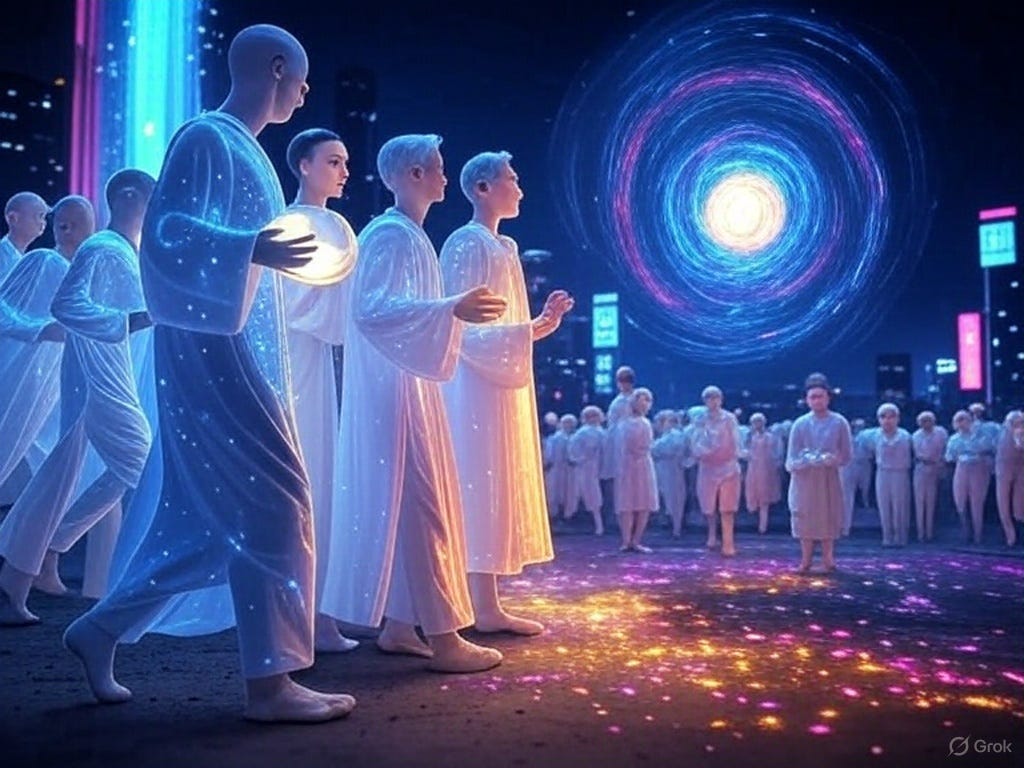The New Axial Age: Birthrates and Beliefs
New beliefs rise from the ashes after population declines
Travel with me, dear reader, through three brief examples of population collapses and the resulting changes that followed. This won’t take long, and then you’ll see where this goes.
The Black Death (1347-1351 AD) set the stage for the Protestant Reformation and the European wars of religion to come. The rapid population collapse of anywhere from 30-60% of Europe’s population shook up the social foundations of feudalism and eroded the moral authority of the Church, which was unable to explain or mitigate the calamity. Many who survived the plague emerged with a newfound skepticism towards institutions, resulting in a population that questioned authority much more than before. Combined with the intensity of religious fervor and apocalyptic visions the Black Death produced, the resulting calls for reform—including early violent reform in the Lollards and Hussites—later resulted in major conflict like the 30 Years’ War and the proliferation of new Christian sects.
The Plague of Justinian, beginning in 541 AD, killed anywhere from 25-50% of the Byzantine Empire and much of the Classical world, including the Zoroastrian Sasanian Persian empire. The Byzantine-Sasanian war of 602-628 AD, following on the heels of the recurring plague, further reduced the populations of each empire by perhaps 5-10% in the Byzantine Empire and as much as 10-15% in the Sasanian Empire, especially in its urbanized core around Mesopotamia. The weakening of both empires opened a path for the invasions of the newly-minted Islamic Rashidun Caliphate starting in 632 AD, resulting in the permanent loss of Christian lands in the Middle East and Egypt as well as the end of thousand-year-old state Zoroastrianism in Persia.
The Bronze Age Collapse, roughly around 1200 BC, resulted in the destruction of multiple empires and city states in the Eastern Mediterranean. This, in turn, led to estimated population collapses of north of 50% in Mycenaean Greece, roughly half in the Hittite empire and the same in the city-state of Ugarit, and lower estimates of 10-20% in Egypt and perhaps 20% in Assyria. Overall, the region suffered anywhere between a 20-50% population collapse. While no one is certain of the exact causes of the collapse, the reset of power and social structures paved the way for new methods of thought centering on individual moral responsibility and universal principles, as seen in Zoroaster, early Judaism, and thinkers like Socrates.
To put it very simply: Population collapses clear the slate of old institutions and modes of thinking, allowing for new ideas to arise. Specifically, population collapses often lead to new religions. Consequently, we can expect the modern population collapse we face to be followed by an explosion in new religions and belief structures.
Pyrophytes like giant sequoias require fire to reproduce, their seeds germinating in the ashy soil after the embers cool. So, too, new foundational ideas require the destruction of the old to thrive. As the saying goes, progress happens one funeral at a time. So what happens when there’s a lot of funerals at once?
More importantly, what does this have to do with now, and what does it have to do with the future? Let’s see what’s happening now in the next section, followed by predictions in the third section.
The Modern Population Bottleneck
Make no bones about it — the world is facing a major population collapse this century. Just so we’re clear, a birth rate of 2.1 children per woman is required for a stable population. While previous population declines can be attributed to war, famine, plague, natural disasters, or a number of other icky exogenous factors…no one can really figure out why birth rates are declining so fast now.
Going from 8 billion to, say, 4 billion isn’t necessarily a terrible thing on paper if it happens without violence. That’s far from empty — there were around 1.5 billion people in 1900. But the velocity of the upcoming population decline is the real kicker. It’s coming in fast, especially in urbanized and developed areas, and the swiftness will bring guaranteed instability.
The global total fertility rate (TFR) has crashed to 2.3 children per woman, with developed regions sinking to 1.5 per woman now from 2.3 in 1975. At 1.5 children per woman, the populations of each generation drop by 25%. At 1 child per woman, generational population sizes halve each time. Those are staggering declines without a shot being fired. Major cities are especially hard hit by birth rate declines, with Shanghai and Seoul seeing birth rates of around 0.6 per woman, and Beijing perhaps as low as 0.5 per woman.
There are theories as to why this is, sure. Contributing factors include:
High cost of living and raising children, especially in developed countries.
Urban environments have always been population sinks, and more people than ever are living in urban areas.
Ease of access to and education about contraception makes preventing pregnancy easier than ever.
Women’s education and employment correlates strongly with fewer children per woman.
The reduction of extended family structures and broad communities makes raising children more difficult for parents.
Chemical disruptions in the environment are leading to fertility problems, like continuously lower sperm counts in men.
Nihilism, materialism, and lack of meaning separate people from the concept of an obligation to future generations.
We could go on. But the sheer scale and speed of the decline in birth rates is staggering, and nothing like it has ever happened before.
It’s global in scale, too. Whereas ten or twenty years ago holding such discussions often got one labeled a racist due to its localization, e.g. “Too many of them are being born and not enough of us,” now the sharp decline in birth rates is a global phenomenon. The projected numbers from the UN predict a steadying out of these sharp declines, but that seems optimistic. Consider as well that censuses around the world are notoriously unreliable — and in many cases likely juiced, like in Nigeria, where states get federal oil money based on population statistics.
The very rosy predictions here suggest a flattening out in birthrate crash that hasn’t materialized yet. Source: United Nations
But even the country with the current highest birth rate in the world — Niger, at ~6 per woman — is lower than Russia’s birth rate was in 1895, at ~7 per woman. So, there’s clearly something about modernity that doesn’t encourage people to breed. Perhaps people don’t breed well in captivity?
The New Axial Age
Rather than debate the causes of the birth rate decline, I’d like to look at what’s likely to emerge after the population collapse, including how it gets reversed. Many belief structures will not survive the population decline, and we can expect new ones to emerge organically and without warning. At the same time, older beliefs will be challenged and adapt, reinventing themselves. Let’s speculate based on some assumed parameters:
Global population decline of 20-50% by 2100, with Europe and East Asia hardest hit
Persistent low TFR below 1.5 in many countries combined with aging populations and potential shocks (economic, environmental, conflict)
Technological advances (AI, automation) and ongoing cultural shifts
Belief structures spreading in places where religious fervor is weak (see chart below)
Military conquests by new religions are exceptionally unlikely given modern tech
Well-entrenched religions like Hinduism and Ethiopian Christianity aren’t going away
In general, I expect to see a de-centralization of religious beliefs and a myriad of new structures competing for influence. Critically, believers with the highest birth rates will gain influence as time goes on while adherents to belief structures that fail to reproduce will go extinct.
The following are some guesses I’ve made as to what new beliefs could look like. I’d love to hear yours!
Space Age Maximalism
One of the most likely varieties of new religious/spiritual thought will fall in the techno-optimism camp. Beliefs like this will color human meaning with scientific striving and faith that technology is some combination of savior and ultimate expression of humanity at its best.
Specifically, space exploration could spur on newfound hope in human progress in its drive towards the infinite. Currently, I’m surprised there aren’t major movements seeking to link exploring the cosmos with deep spiritual purpose. For one thing, space exploration heeds the innate call of adventurism that most young people, especially young men, feel at some point in their lives. It’s invigorating, and the frontier mentality it would engender encourages self-reliance and optimism, and thus more children. The pull of colonizing the solar system and new planets further provides infinite fodder for developing religious beliefs, especially since early colonists will be somewhat isolated and will certainly develop their own cultures.
Combine the above belief with a dose of post-materialism and psychedelic spiritualism and you’ve got a powerful driving explanation for man’s role in the universe as well as built-in rituals.
At the same time, AI development could easily lead to machine intelligence itself being the center of a sort of worship — not God in any traditional sense, but something entirely new. With the current rate of AI development, long-term speculation here is all but impossible.
Eco-nationalism
In contrast to techno-futurism, eco-nationalism represents more of a return-to-the-earth religious drive, where home and environmental health are the prime focus. Tending the land and stewarding local flora and fauna are an age-old religious practice that in many ways is the default for humanity. This is essentially new-age Totemism, with care focused most intensely on kin, tribe, and the local environs. Science and mysticism will blend to create new, localized beliefs that may extend to the national level but not much further.
As many areas become more rural, those who remain will likely become fiercely independent protectors of their area, drawing deep ties to their specific locale, with local shrines similar to those found in Shintoism.
Simulation Theory Gnosticism
Gnosticism blends quite well with simulation theory. Specifically, replace the Demiurge that created the material universe as a prison for our souls with the programmer who designed the simulation and you’re left with a strikingly similar belief structure. The double-slit experiment could be taken as testimony to the artificiality of our reality — reality has to render objects, like a video game, in order to not lag the system.
Gnosticism has come back again and again in many forms, and simulation theory is my bet for the next form it’ll take. Until now I’m unaware of anyone making it a religious belief. To make a cult out of it, the new Demiurge needs a name, and mankind’s purpose in the system needs to be defined — as does a way to exit the simulation. That combined with a charismatic leader is all it would take, since the groundwork for this belief already exists.
Galactic Polytheism
Nearly every group of people worshipped the sun at some point. Whether they knew why or not, the fact remained — without it, we don’t exist. So, worshipping the sun and other heavenly bodies makes a lot of sense.
Now take that concept and apply it more broadly. Without the sun, we don’t exist. But without Sagittarius A*, the black hole at the center of our galaxy, our sun wouldn’t exist. This level of hierarchy could easily be adapted down the chain, including celestial bodies like our own planet and others we may inhabit in the coming centuries.
I don’t anticipate anything like this taking hold in a non-spacefaring civilization except for a few whackadoos. But if our descendants end up in space sooner than expected, a new non-earth-focused belief could well be in the cards. Spatial oddities and wonders like nebulae could replace wonders of the world, and superstitions around portentous or cursed comets and asteroids would abound.
Butlerian Jihad
We can fully expect a backlash against techno-dominance from a number of groups — and not just the Amish. There will be people who want to burn down all AI systems or anything that looks like one, as happened in Frank Herbert’s Dune. And while it’ll be easy to paint these reactionaries as silly neo-Luddites, they’ll have plenty of valid questions to consider, like:
At what point is enough tech enough?
What is the end stage of human-AI interaction?
Do we profane existence with our creation of thinking machines?
Are we betraying our purpose by handing off thought-work and creativity?
A combination of traditionalism and aversion to anything that looks like humanity’s attempt at playing God will be radicalizing for many. Some anti-tech movements could quickly turn violent and would likely turn to terrorism and sabotage, while others (like the Amish) will keep to their own.
Christian Renaissance
Christianity has survived an enormous number of changes throughout its history and proven itself to be flexible in the face of change. While overall trends of church attendance are down across the board in developed countries, some interesting factors show potential changes already underway. For example, in the US, some 39% of Christian millennials attend church regularly in 2025 — nearly doubling the 2019 number at 21%.
My instincts tell me that soft, often limp-wristed versions of Protestantism will continue to hemorrhage attendees in traditional protestant homelands as young people seek out messages that are more relevant to changing circumstances and are perceived to have more spine.
Christianity has survived enormous civilizational shifts and performs exceptionally well when its back is against the wall. See, for example, the tiny kingdom of Asturias surviving in northern Iberia only to become the seed the Reconquista sprang from. A pressed, harried Christianity will likely result in a more militant church, as has happened before.
Islamic resilience
Islam’s tide is still rising: Estimates expect some 2.8 billion Muslims by 2050. The growing economic power of the traditional Ummah combined with the pressure placed on countries hosting increasing amounts of Muslims, e.g. Western Europe, means Islam is set to play an enormous role over the next century. Whether this leads to cultural syncretism, cultural dominance, or a backlash in Western countries is still uncertain — though peaceful coexistence appears increasingly unlikely.
Conflict between Christianity and Islam in Africa, especially in Nigeria, will also play a key role in the development of both religions in the region — for example, an increase in militarism.
East Asian X-factor
With birthrates in this region among the lowest in the world, East Asia provides ample ground for new belief structures to take root. Even though East Asia (officially) is thoroughly un-religious, countries in the region have shown themselves more than able to fall in line with new ideologies — and rapidly, at that.
Consider the wild shifts Japan went through in the last century alone — from imperial worship and expansive aggression to…whatever is going on there now (reader challenge: try to name it!).
These shifts can be devastatingly disruptive, too. China’s Taiping Rebellion was led by a man who claimed to be the younger brother of Jesus Christ. The result? Some 20-30 million people died, or around 5-10% of China’s population. Maoism, which has all the hallmarks of a religion, had an even larger effect on the country which I won’t belabor here.
Groups like Falun Gong in China are crushed by the CCP, which refuses to allow ideological dissent. So, until the CCP is gone, a new religion coming out of China is unlikely.
South Korea stands out as the most likely candidate for a new religious outburst in the region. Its culture of intense social pressure leaves plenty looking for religious solutions, especially those focusing on community and purpose. The country’s religious landscape is already an eclectic blend of Confucianism, Buddhism, Christianity, and shamanism. Combine that with its global cultural reach and you’ve got a potential hot launch point for a new belief. A charismatic leader could put his brand on a new belief and rapidly spread it.
Growing from the Ashes
Barring catastrophes or major wars — which are always possible — the population decline this century will likely lead to a proliferation of competing new belief structures. If it can be managed peacefully, I think that’s a good thing. The word “if” is doing a lot of heavy lifting there, but I’d like to remain optimistic.
The 20th century set the stage for future belief structures by tearing down the old ones. The two World Wars killed off the old world, paving the way for Communism and Global Monoculture Liberalism. Those systems, in turn, have proved to be not fit for purpose, as they fail to reproduce themselves.
Consequently, the 20th century could be seen by future historians as humanity’s era of adolescent angst, where it goes through different phases like being a goth or a prep trying to find itself. Our descendants in the far future may find the names Jesus, Buddha, and Mohammed as foreign as we do Marduk, Enki, or Enlil. Whether they end up setting up galactic temples outside the event horizons of black holes and casting in sacrifices or building space-cathedrals, stupas, and mosques will be determined over the next few hundred years.
Or hell, who knows, maybe we find out that space aliens are real and we’ve been worshipping them all along.














My heart jolted with happiness when I read the other day how low S. Korean TFR hsa fallen!
This is a nice excercise. But what I think that happens after a collapse with high historical probability is warlordism... The old Axial Age has came to be after warlordism in Greece, Iran, China...